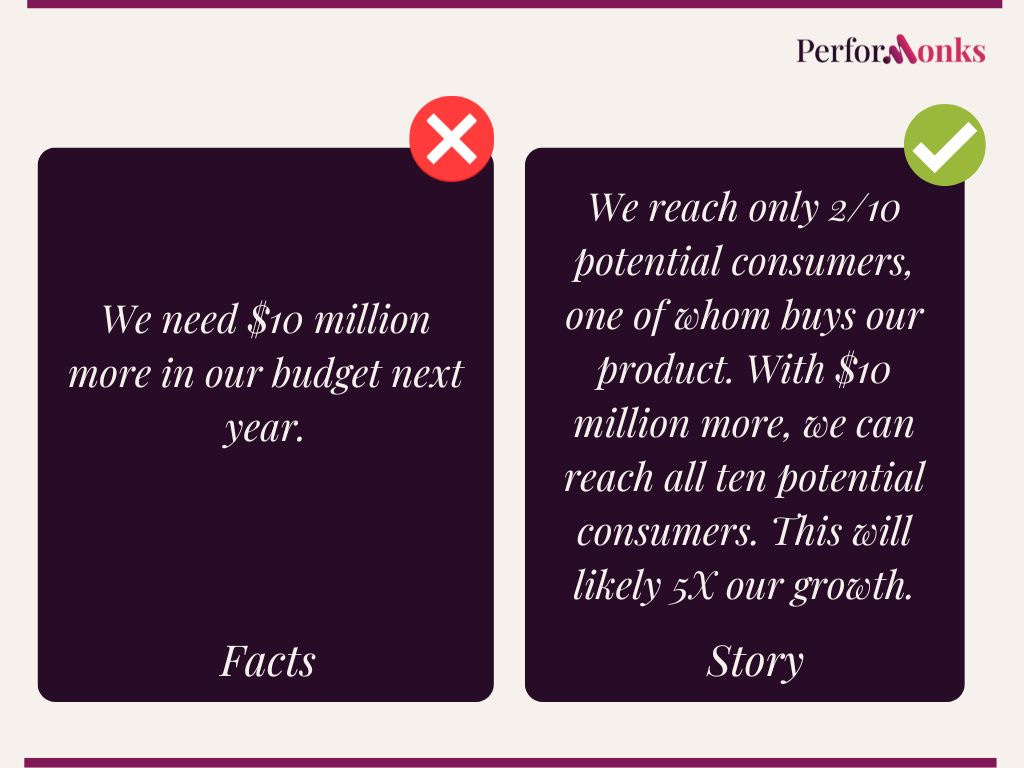The art of storytelling is not limited to bedtime fairytales, nor is it the exclusive domain of career storytellers in Hollywood, Bollywood, or Netflix.
Stories are an essential swiss army knife in every marketer’s toolbox.
If like me, you’ve also found yourself in the same situation as Monica, then read on.
This is part 1 of a multi-part series on the art of practical storytelling. We’ll explore how to weave narratives that sway opinions, stir emotions, and spark action in the real world.
Let’s dive in.
Our brain is hardwired for stories
Our brains are hardwired for stories. Not by accident, but through centuries of careful evolution.
Our brain saves energy and increases chances of survival by automating decisions. Instead of drowning in oceans of data, our brain converts data into patterns and stacks of meaning – stories.
Think of it this way. Every human face has two eyes, one nose, a mouth, a chin, and a forehead. Yet, even in a dim, crowded room, we can pinpoint our mother with ease. Why? It’s because our unconscious brain is packed with stories about her that ignite with just a glimpse of her face.

In essence, our very act of thinking – navigating chaos, making sense of the world, and making lightning-fast decisions – is nothing but a result of internal storytelling.
Let’s test this theory
Quick. Memorize these twelve words.
Manali, Fourteen, Five, Rabbits, House, Fox, Three, Rainbow, Petal, Doll, Gardener, Hutch.
Done? Now, without peeking, how many can you recall?
Now, read this.
The Rabbits and the Fox: Back when I was 5, we lived in Manali, at house number 14. I still remember it because my birthdate is also 14. Inclined to believe in this sort of thing, I took this to be a good omen.
I was even more convinced of the lucky powers of the number 14, when we discovered three baby rabbits in the backyard. Snow-white with eyes like melted chocolate, it was love at first sight.
I named them Rainbow, Petal, and Doll and watched them grow into fluffy bundles of mischief. I started and ended my days by playing with them.
Our house was away from the hustle of the town and prone to visits by wild animals like foxes and leopards.
One morning, as per my usual routine, I jumped out of bed and ran to the rabbits. But they were missing! The gardener said a fox must have snatched them away at night because I had forgotten to latch their hutch.
This was my first heartbreak. I wept for days and could not forgive myself. I still remember this incident vividly because at that moment, I grew up and realized the world is not perfect. Here, bad things can happen to good people.
You may have memorized the list of words perfectly for now, you might even forget them soon… but you won’t forget this story easily.
This list of disconnected words became sticky the minute they were woven into a story.
People remember information when it is weaved into narratives “up to 22 times more than facts alone.”
Jennifer Aaker, Marketing professor at Stanford GSB
This is the rationale behind Rule No.1 of the art of storytelling – Prioritize stories over facts.
The best example of this is the iPod story, which converted the snoozefest of technology facts into one simple consumer benefit.

Here are a few more examples that bring this to life.
1) Express your requests in the form of mutually beneficial outcomes.

2) When there are many numbers, express them in relation to each other and indicate their trend.

3) Convert facts (features) into a relatable equivalence.

Same facts, different stories
This brings us to another interesting twist in the art of storytelling – with the same twelve words, you could write a completely different but equally meaningful story than the one I wrote.
It’s because our experiences and worldviews are different.

And that’s the power of human imagination – the same seven musical notes, twenty-six alphabets, and three primary colors have sparked countless lifetimes of creations.
Equally, this also presents the biggest challenge for marketers and storytellers – how do we make sure our stories trigger the intended imagination in the audience’s mind?

It’s challenging enough in a one-to-one conversation. In a one-to-many scenario, like in an advertising campaign, it feels Herculean.
That’s when Rule No. 2 helps – lean into universal emotions.

The story about The Rabbits and the Fox elicited emotions and pictures in your brain. You ‘saw’ in your mind’s eye house no.14 in Manali, three snow-white rabbits, a fox carrying the rabbits away in the middle of the night, and a little girl crying for days.
Details and facts are irrelevant.
Whether you had a pet or not.
Whether your pet was a dog or a parrot.
And even if the house you imagined is different from the house I imagined.
It does not matter.
What matters is that the themes of love, loss, cynicism, betrayal, delusion, or power are universal.
Even if you’ve never lost a pet, you’ve lost something or someone. You’ve loved. You’ve had your heart broken and felt that the world is unfair.
You empathized with the growing-up story of a little girl. That’s what matters.
The emotion you felt hard coded the story into your brain… in the box with more such similar experiences.
So how does one weave emotion into stories? In boardrooms, in one-on-ones, in one-to-many, in crucial conversations?
That’s for next time.
Thanks for reading!
